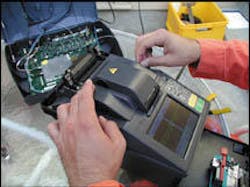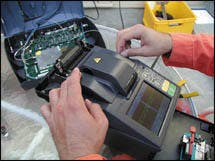Gauging the future of FTTH
By ROBERT PEASE
Providing residential customers with bundled high-speed voice, data, and video service with the limitless benefits of fiber isn't a new concept. The key, however, has always been to bring the cost down to an acceptable level for the consumer. Competing technologies such as DSL and cable modem offer more affordable data services, putting fiber deployment on seemingly indefinite hold. That, however, could change very quickly if fiber-to-the-home (FTTH) system providers have their way.
Marconi (Pittsburgh) has a one-year trial underway in Palo Alto, CA, that will provide valuable information regarding customer satisfaction in terms of service and cost. The one-year trial offers 75 residences in Palo Alto's Community Center Neighborhood with bundled voice, data, and video services over fiber infrastructure supplied by the city. Services are delivered through a passive optical network (PON) between the customer's home and Marconi's host digital terminal located near the city's municipal service center.
"The trial is to determine the marketing and business parameters of a deployment," says Mark McDonald, vice president of product marketing at Marconi. "On the marketing side, they want to determine what the service uptake will be and how much people are willing to pay for the service. In addition, they are trying to gauge the sentiment of the residents toward paying an assessment to help defray the cost of the fiber deployment."
The city of Palo Alto hopes to determine the structure and economics of working with service providers. Since they are a not-for-profit organization, they want to explore the business arrangements in seeking a win-win business case for the city and potential service providers. For Marconi, the company has a keen interest in how its service set is accepted.The centerpiece of Marconi's efforts in the project, the FTH-1000, is a PON extension of the company's fiber-to-the-curb product. Marconi is a strong believer in the future of PON technology and plans to support it on other platforms deployed globally. With an apparent debate about how best to deploy FTTH and fiber-to-the-business (FTTB), Marconi believes PON is the most economical for residential use, allowing a large portion of the optical plant to be shared among several homes. However, the jury is still out on whether PON is best for business deployments.
The Marconi system was designed from the beginning to serve a residential market. On the network side, the FTH-1000 interfaces to a standard switch using all the available telecommunications interface options. The network data interface is 100Base-T for up to 16 homes. The video interface is a standard analog trunk signal for the cable television and Harris/Echostar direct broadcast satellite (DBS) signal provided by a dish antenna.
On the optical side, the split ratio is 4:1. The product uses WDM techniques to provide the multiple services. Data and voice are carried on one wavelength and the video on a separate wavelength.
"The product's appeal is its simplicity," says McDonald. "All the interfaces are currently available and based on standards. This simplicity is something that our customers come to appreciate over time. They usually start out with greater ambitions, especially with respect to the data service. However, after trying to implement voice and video service using a streaming packet solution, they begin to appreciate the necessity of using more proven techniques for these services."
In the Palo Alto trial, residential customers will be offered three phone lines, high-speed data connectivity with 7 Mbits/sec downstream and 4.5 Mbits/sec upstream, and a DBS service. For the one-year trial period, the phone lines are free, data services will cost $85 per month, and an existing DBS provider will provide video service. Although the exact consumer cost was not established at press time, homeowners will pay the DBS provider for video service, and the city of Palo Alto will receive a fee for transporting the signal to the home.
The city of Palo Alto was a key driver in deploying an FTTH solution. In the heart of Silicon Valley, Palo Alto has a large percentage of its population employed in the high-tech industry. Residents initially lobbied the city to install 100Base-T Ethernet to each home, but it was too expensive. The city studied a streaming video offering to ride on the 100Base-T Ethernet but decided it was too complicated and would add even more cost to the system. The Marconi system was eventually chosen from the perspective of simplicity and cost.
Marconi expects to gain critical information from the Palo Alto trial regarding future FTTH deployments. A successful trial would lead the way for other municipal utilities to consider their own deployments of FTTH. The trial could also help consolidate the business model that supports FTTH deployment and put to rest some of the debate over cost comparisons.
More specifically, however, the trial must measure consumer acceptability for using and paying for the services. Marconi wants to determine which services customers want to receive over their fiber connection and what price they view as reasonable for those services. But even if the price is reasonable to the consumer, there are still lots of barriers to any future mass FTTH deployments by providers.
"There are fundamental barriers regarding the uncertainty of the revenue stream and the cost of deployment in an established neighborhood," says McDonald. "A consensus is building that FTTH is affordable in 'greenfield' applications and, possibly, for aerial overbuilds. It is not yet certain that a general area, with a mix of deployment requirements, can offer a sustainable business model."
Much of the concern also lies with utility clients and their belief that equipment is too complex for staffs to handle. Fiber handling requires a different set of skills than traditional copper plants, and there is fear that it may be beyond the capabilities of the current staff. Retraining personnel and equipment changeover may also be an issue.
McDonald further believes the industry may have pushed the technology envelope too far. Some systems based solely on delivering streaming content require new and untested methods of service delivery, such as voice over Internet Protocol or streaming video. The technologies are intriguing, but they may be relatively unproven in a business sense. Combining them with a yet-to-be-proven FTTH deployment may be a tough bridge to cross.
"By and large, most individuals would like to receive a fiber-based service if there is an affordable service option for them," says McDonald. "They may not need all the capacity, but it's nice to know it is available, and it will probably increase the value of their property. However, communities of individuals become concerned about the disruption caused by the installation of the service."
So when will the average consumer have the benefits of fiber in the home? Even providers like Marconi believe we're many years from the day fiber will provide most telecommunications services to residents nationwide. Expense is still the key issue, but as volume builds, the price should drop, making FTTH affordable to more than just the affluent few.
Government incentives and a favorable regulatory environment will likely be necessary to encourage widespread investment in fiber infrastructure to support FTTH. Service disruption resulting from fiber deployments, not to mention the cost of ripping up neighborhood streets where necessary, will not make it easy to convince consumers that fiber is the right and immediate choice.
Major telecommunications companies refurbish about 5% of their network each year-in essence, rebuilding the entire network every 20 years. That, says McDonald, is the time frame one needs to use in thinking about the conversion to FTTH. It likely will be 20 or more years after the conversion begins before most homes in the United States are directly connected to an optical system.
"Some may argue that the conversion has already started if fiber-to-the-curb and fiber-to-the-node systems are included," says McDonald. "I think that's a fair argument. But it will still take on the order of 20 years to complete the conversion."
Matthew Davis, program manager of e-networks and broadband access for the Yankee Group (Boston), believes that while FTTH is still in the early stages of development, trials like Palo Alto are producing valuable data on the costs associated with delivering the technology. The trials also help establish revenue benchmarks for service providers regarding what they might expect to generate from a converged voice, data, and video service.
"While there are issues concerning which will be the ultimate technology employed, such as APON [ATM PON] or EPON [Ethernet PON], we believe that a megabit converged voice and data transport technology will gain a significant foothold over the next decade," says Davis. "Despite the great promise of FTTH, it will face an uphill battle to displace cheaper and more established technologies like DSL or cable modem in the nearer term."
Although it's exciting to talk about 100-Mbit/sec service in the home, the reality is that just 10 Mbits/sec will still be completely adequate for many years. It may be more important to focus attention on building fiber infrastructure that will allow delivery of 100 Mbits/sec when it does become economical to deliver and applications demand that level of capacity. As Marconi's McDonald puts it, "The promise and the fact is that once the fiber is installed, the service capability can be expanded with no foreseeable limit."
For more information about Switching for Optical Networks visit Lightwave Online! at www.light-wave.com

